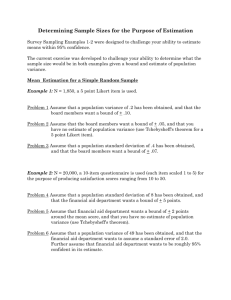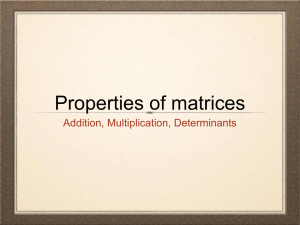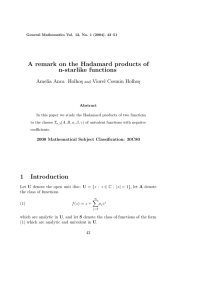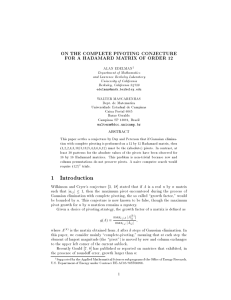How Tight is Hadamard's Bound? John Abbott and Thorn Mulders
advertisement
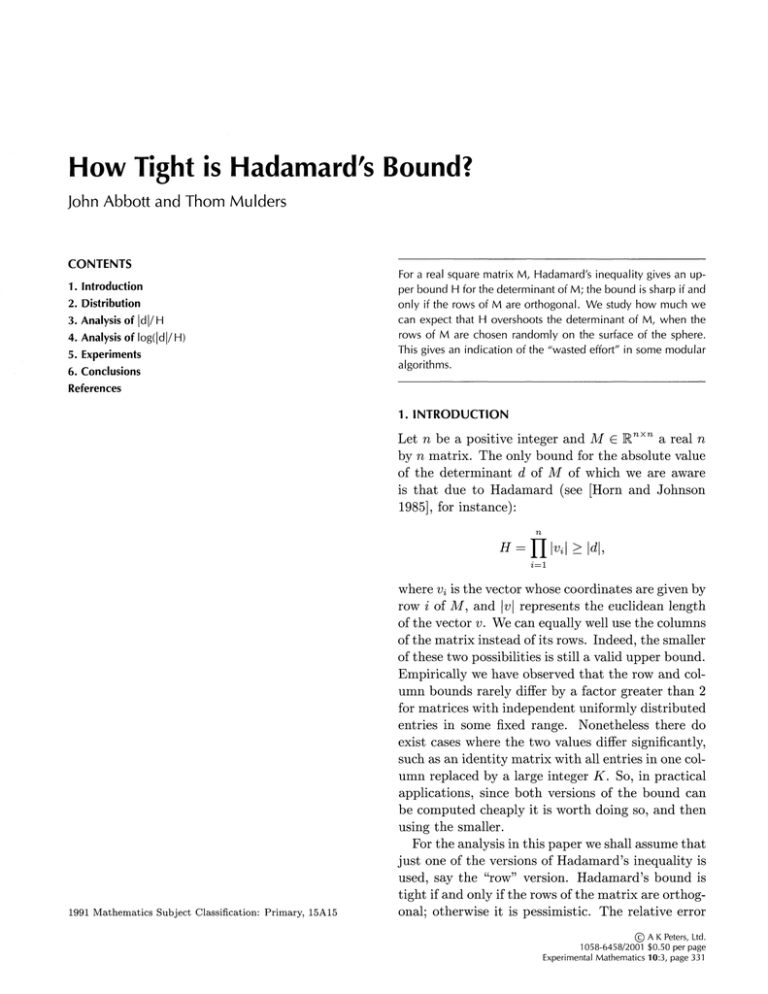
How Tight is Hadamard's Bound?
John Abbott and Thorn Mulders
CONTENTS
1.
2.
3.
4.
5
Introduction
Distribution
Analysis of |d|/H
Analysis of Iog(|d|/H)
Experiments
~
, .
r
6. Conclusions
For a real square matrix M, Hadamard's inequality gives an upp e r bound H for the determinant of M; the bound is sharp if and
only if the rows of M are orthogonal. We study how much we
can expect that H overshoots the determinant of M, when the
rows
°f M are chosen randomly on the surface of the sphere.
^ n i s 8 l v e s a n indication of the "wasted effort" in some modular
algorithms.
&
References
1. INTRODUCTION
Let n be a positive integer and M E Rnxn a real n
by n matrix. The only bound for the absolute value
of the determinant d of M of which we are aware
is that due to Hadamard (see [Horn and Johnson
1985], for instance):
H = f[\Vi\>\d\,
2=1
1991 Mathematics Subject Classification: Primary, 15A15
where Vi is the vector whose coordinates are given by
row i of M, and \v\ represents the euclidean length
of the vector v. We can equally well use the columns
of the matrix instead of its rows. Indeed, the smaller
of these two possibilities is still a valid upper bound.
Empirically we have observed that the row and column bounds rarely differ by a factor greater than 2
for matrices with independent uniformly distributed
entries in some fixed range. Nonetheless there do
exist cases where the two values differ significantly,
such as an identity matrix with all entries in one column replaced by a large integer K. So, in practical
applications, since both versions of the bound can
be computed cheaply it is worth doing so, and then
using the smaller.
For the analysis in this paper we shall assume that
just one of the versions of Hadamard's inequality is
used, say the "row" version. Hadamard's bound is
tight if and only if the rows of the matrix are orthogOnal; otherwise it is pessimistic. The relative error
© A K Peters, Ltd.
1058-6458/2001 $0.50 per page
Experimental Mathematics 10:3, page 331
332
Experimental Mathematics, Vol. 10 (2001), No. 3
H/\d\ is sometimes referred to as the orthogonality defect (see [Clarkson 1992], for example). However, to avoid difficulties which arise when d = 0
we shall work instead with \d\/H. In particular,
we shall determine the expectations and variances
of the random variables \d\/H and \og(\d\/H) for
matrices whose rows are random vectors uniformly
distributed on the surface of a sphere. The former
random variable takes values in the interval [0,1]
while the latter is nonpositive.
The interest in the tightness of Hadamard's bound
is stimulated by algorithms for computing exactly
the determinant d of an integer matrix. One way
is to use Chinese remaindering: compute a modulo
several distinct primes, pup2,...
,pfc, and then combine these modular images of d [Bareiss 1972]. We
obtain the correct answer provided that UieiP* >
2|d|, but since we do not generally know \d\ in advance we use instead the sufficient condition that
UieiPi > 2H- T h u s ^g(H/\d\) is a measure of the
"wasted effort" using this method.
Another way of computing d is given in [Abbott
et al. 1999] and works by computing quickly some
(probably large) factor D of |d|, and then using Chinese remaindering to find the value of d/D. A suitable D arises as the least common denominator of
the solution of a linear system Mx = b for a random
integer vector b. Once again \og(H/\d\) is related
to the "wasted effort", and the same article gave
asymptotic upper and lower bounds for its mean.
In this paper we improve these bounds and give ex.. .
,
, ,
,
.
I/rr
plicit rformulae rfor both mean and variance ofM J\d\
H
^' "
, „
,
.
Henceforth we snail assume that the matrix cli_ .
.. .
. . ,
mension n is at least 2, the case n = 1 being trivial.
n-sphere. Our assumed distribution is that these
points are independently and uniformly distributed
on the surface of the sphere. Thus our study becomes that of the random variables \d\ and log|d|.
Now, viewing the absolute value of the determinant as the volume of a parallelepiped we see that
it can be computed as a product of sines of certain
angles. We define n — 1 angles as follows: let cpi
be the angle between vi and v2, let (p2 be the angle
between span(^i,^ 2 ) and v3, and in general let (pk
be the angle between span(i>i,..., vk) and vk+1 for
k up to n — 1. It is clear that
\A\ We
focus
our
attention on (pk for the moment. We
S
Y finding the density function for tpk, and
by s mmetr
^
^ w e c a n s u P P o s e t h a t Vk G [<W2].
Let W
k = s p a n ^ , . . .,!;*), a subspace of dimension k
- T l i e vector vk+i can be written uniquely
as t h e s u m of t w o
components: vn lying in Wk and
v
± perpendicular to Wk. Furthermore |^||| = costpk
and
K l = sin¥>* b y definition. Thus all unit vectors
forming an angle yk with Wk are generated as
t h e s u m of a v e c t o r
lying on the ^-sphere of radius
COS(
^ i n s i d e W* w i t h another vector lying on the
( n ~ fc)-sphere of radius s i n ^ inside W£. Whence
we see t h a t t h e
density of <pk as a function in 0 is
proportional to (sinfl)"-*" 1 (cos^)^ 1 .
be
in h
3. ANALYSIS OF |d|/H
. r
JJ-X-T_XJ
n.
TT
Since H = 1 tor our assumed distribution, we need
,
,
,
,
,,
,
.
,
.^
,
,.
x
n
on
^y study \a\. Tltr
We determine
first its expectation,
then its variance. Thanks to the symmetry of the
,
,,
,
, n . -,
sphere, the angles ^ i , . . . , ¥ ? n - i a r e mutually
mde, x
,
pendent, and so
n-l
2. DISTRIBUTION
E(\d\) = J J E{simpk).
The first point to establish is our assumed distribution on the matrices. We regard the matrix dimension n as being arbitrary but fixed. We shall
avoid all matrices containing a row of zeroes because they give d = H = 0. Now, the value of
\d\/H
is unaffected if we scale any row of the ma! 7 ,
i
xi
XT x
trix by a nonzero value; thus we may assume that
,
,
Ti
i
,i -,
i
i
each row has euchdean length 1, and consequently
that H = 1. Such matrices can be viewed as specir-
-x
xi
r
m
-x
fymg n points, vu . . . , vn, on the surface of the unit
(3-1)
~
S a m m a function and let B be
t h e b e t a function
> defined by
1
f
_
_
r(p)T(q)
B
M
= JQ & ^ " x)q dx = T(p + q) ( 3 " 2 )
^
r
r
Grobner and Hofreiter 1961, 421.1 . Then, for non. . J
.
Let T be the usual
negative integers r, s, we nave
r/2
/
Jo
.
x D/r+1
s+n
( s m 0) ( c o s ^) ^ = ^ ^ ( ^ , ^ )
._
ox
3-3
Abbott and Mulders: How Tight is Hadamard's Bound? 333
[Grobner and Hofreiter 1961, 331.21]. (The facts we
will need about special functions can also be found
in [Abramowitz and Stegun 1972; Gradshteyn and
Ryzhik 1980; Luke 1969].)
Using (3-3) and (3-2) to integrate our density
function, we get
«TT/2
(sinfl)"-* (cosfl)*-1 d6
/
/
(sine)"-*" 1 (cosO)1*-1 d6
Jo
= B(*=p±, |) /B(*±,
=
Again, since the tpk are mutually independent, we
have
"_^
E d 2
(\ \ ) = HE ( ( s i n ^ ) 2 ) •
(3"4)
k=1
As before we use the density function and equations
(3-3) and (3-2), together with the functional relation T(x + 1) = xT(x), to get
/
E(sm2 <pk) = ^
|)
(sine)"-"*1 (cos O^dO
V (smey-^(cose)^de
r( f )r(^p)
= B {*=**, |) /s(*=*, |)
r(n±l)r(n^j-
=
By substituting this in (3-1) and telescoping the
product we get
The asymptotic behaviour of E(\d\) can now be derived easily from the equality F ( | ) = ^ and from
the asymptotic expansion of the logarithm of the
gamma function, which is
, j^( x /
ni
. log(27r)
1
_2
logr(a?) = (x-\)\ogx-x+—
+ —-+O[x )
for x > 0. After suitable simplification we obtain
the following lemma.
„ , . ,1N
^ / iw
/o 4/T- /H
n/2
Lemma 3.2. E(\d\) = e~ \/4e(l + O^n-1)).
Vl Iy
v
Informally, this means that for large n on average
det M is smaller than Hadamard's bound by roughly
a factor of e~ n / 2 \fAe.
We cannot compute E(l/\d\) since we encounter
an unbounded integral:
r/2 (cosfl)-2
M
J
sine
u
-Bfl/sm^^.i) =
,2
= oo.
/
Mn-2 jn
/
Variance of |d|
Further understanding of the behaviour of |d| comes
from knowing its variance. We shall use the wellknown formula var |d| = E(\d\2) — (E(\d\))2 for our
computation. We have obtained .E(|d|) above, so
turn immediately to E(\d\2).
n-fc
n
Substituting this in (3-4) we get
Applying the asymptotic expansion for the logar i t h m o f t h e g a m m a function we obtain:
E
{\d?) = e~n^/27^n (l + O(n~ 1 )) .
Combining this with Lemma 3.2 we get the asymptotic behaviour of the variance:
Lemma 3.3. varldl = e- n (v / 27rn-\/4e)(l + O(n- 1 )).
x
7
Chebyshev's Inequality [Lukacs 1971] relating variance to probable deviation from the mean now tells
F
,
...
f
f
us that indeed |a| is unlikely to stray too tar trom
the expected value: with a probability of at least
95% we have that |d|/-B(|d|) does not exceed 4n1//4
for large n, though we get no information about how
much smaller than its mean \d\ might be in multiplicative terms.
4. ANALYSIS OF Iog(|d|/H)
Once again recall from section 2 that we have H — 1
for our assumed distribution, so in fact we need only
study log|rf|. In [Abbott et al. 1999] bounds for its
expectation were obtained using Jensen's inequality
[Breiman 1968]. Here we obtain an exact formula as
well as the first terms of its asymptotic expansion
(using elementary functions). Afterwards we ascertain the variance finding both exact and asymptotic
formulae.
334
Experimental Mathematics, Vol. 10 (2001), No. 3
The mutual independence of the angles (/?i, . . . ,
(pn-i allows the simplification
Lemma 4.2. The expectation of\og\d\ is given by
\Ogn 7 + log2 - 3
n
" 2 "~ 1
E(\og \d\) — ^ JE(log sin (/?/,).
k=i
(4-1)
To write this in closed form we use the logarithmic
derivative of the gamma function, denoted by \I/; we
have, for nonnegative integers r, s:
,2
(sin9)r (cos 0)s log sin 6 d9
/
- \B(^,
s
-f-) (*(^) - ^i^^))
(4-2)
_
,
r
[Grobner and Hofreiter 1961, 338.6c].
Much as before, writing the expectation as an integral using the density function for (pk and then
. , ° n,
i //r.\
employing (3-3)
and (4-2) we get
y
v /
o
l / /n_^\
/n\\
E{\og sin (pk) = -^S {—^-) ~ * { g ) J - (4"3)
4
+
°{n~1]-
Notice that -E(log |d|) is similar to but not equal to
log(,E|d|). We have
w>(] \j\\ — ^ ° § n , n(i\
4
Of course, that log(25(|d|)) > E(log \d\) follows qualitatively from Jensen's inequality [Breiman 1968].
Informally, this lemma states that the "wasted
effort" mentioned in the introduction is linear in the
dimension n of the matrix and is independent of the
size of entries of the matrix.
,
(jp(\j\\\
Variance of log Id I
,
.
, 7I , r
r,
We now compute the variance of log a . Yet again
*\ , . ,
,
/y, '
.
J_.
x
w e u s e fae mutual independence of the cpk to simplify the computations: the variance of a sum of independent random variables is just the sum of their
individual variances, so
TTr
We reduce the sum to a single closed form expresn—1
SiOn:
varlogM = ^ ( £ ( ( l o g s i n ^ f c ) 2 ) - ( £ ( l o g s i n ^ 0 ) 2 ) k=1
Lemma 4.1. The expectation 0/ log |rf| equals
2 - 7 - 2 1 o g 2 _n_n^/n\
n-1^ fn + 1\
4
2 4 V 2 /
4
V 2 /
Proof. Substituting (4-3) into (4-1) and inverting
the summation order we get
We express the expectation of (log sin <pfc)2 as an integral, and then simplify using (3-3) and the formula
r^/2
/
{smOy {cos6)s{logsm6)2 d6 = I
B(r-^,^)
(4 4)
x (*'(r±l) _ * ' ( r ^ ) + (*(r±l) -*(^f^)) 2 ),
T../X-,
, ,,
. .,-, , ,
. £
Let tin) denote the expression m the statement of
the lemma and 9(n) the sum in (4-4). A straightforward computation, using the value for \I/(|) =
- 7 - 2 log 2 (where 7 is Euler's constant) and the
functional equation
valid for nonnegative integers r, s (this follows from
to
v
, ,
°
r
^ J ^ [ G r 5 b n e r a n d H o f r d t e r 1 9 6 1 '3 2 4 - 8 a D- W e
^(Iog|d|) = j E ( * ( a ) - * ( ? ) ) •
"
J^.^U^
shows that / ( I ) = g(l) and that f(n + 1) — f(n) =
g(n + 1) — g(n) for all n > 1. Whence the lemma
follows.
•
To get a better idea of the magnitude of 25(log |d|)
we use the asymptotic expansion of * ( # ) , which is
logx-l/(2x)
+ O(x-2) for x>0. After simplification we get:
n
^((logsin^)2)
_ I (\$'(n-k\ _ ^(n\ _(_ (\jf(n~k) — \$(ik\)2\ .
(4-6)
The sum representing the variance of log \d\ can
now be telescoped to produce a more compact form
for which we will afterwards show the asymptotic
behaviour. A closed form is given by the following
result*
Lemma 4.3. The variance of log \d\ is given by
n
n
87 + TT2
*(n) n - 1 ,/n + l \
iS)>( \
16 + ~~2~ + ~ 8 ~ \~^2~~) ~ 8 U / '
Abbott and Mulders: How Tight is Hadamard's Bound?
Proof. Putting together formulae (4-5), (4-6) and
(4-3) and inverting the summation order we obtain
Predicted
E
var
n-i
varlog|d| = - y " ( V ( - ) -*'(-))
4
^
V
V2y
47
<")
K2JJ
Let f(n) denote the expression in the statement of
the lemma and g{n) the sum in (4-7). A straightforward computation, using the values \P(1) = —7,
^ 7 ( | ) = |?r2 and the functional equations
.N
T ,
tf(n+l) =
shows that
g{n + i) _
follows
-r / \ 1
i - r / fu+2\
. fn\
4
* ( n ) + - and * ' — - = * ' -,
/ ( I ) = g(l) and that f(n + 1) - f(n) =
5 ( n ) for all n > 1. Whence the lemma
•
Directly applying the asymptotic expansions of *(x)
(given after the proof of Lemma 4.1) and of \l/'(x),
we get
Lemma4.4. varlog \d\ = ±{^+ir2)+\
logn+O(n~ 1 ).
Here again Chebyshev's Inequality shows that for
a given probability e > 0 actual values of log \d\ will
lie within an interval of size O(Vlog^) with probability 1 - s. In contrast with what we could deduce
from our analysis of \d\, here the interval gives us
both upper and lower probable bounds for |d|. Furthermore, for sufficiently large n the upper bound
obtained here is tighter than the one derived earner
-
I
2
10000
3
1000
10
20
-0.693 0.822
°
"
2000
2000
L307
L178
-5.131 1.979
-10.310 2.365
335
Experimental
mean
var
-0.690
"
L297
0.791
L141
-5.117 1.916
-10.379 2.464
'
'
'
'
TABLE 1. Comparison of theoretical and experimental results for log |d| (mean and variance). The values under
"Predicted" come from the formulas of
Section 4, and those under "Experimental" are the
statistics for a sample of N matrices of size n x n.
p
Table
experiments. We
g ° o d a c c o r d w i t h t h e theoretical
results; The expected value of log(|d|/ff) and the
experimental mean differ by less than 1%, and the
theoretical and experimental variances differ by less
than 5%.
see t h a t
*
lists t h e r e s u l t s of t h e s e
t h e r e is
6. CONCLUSIONS
derived formulae for the expected values
a n c j variances of \d\/H and log(|d|/JJ) for a random
m a t r i x M ) w h e r e H i s Hadamard's bound for M
a n d d i s i t s determinant. For all these quantities we
h a v e a l s o g i v e n a s y m p t o t i c expansions in terms of
t h e m a t r i x dimension n. These results improve the
bounds given in [Abbott et al. 1999].
O u r results give an idea of the tightness of Hadamard's bound in the average case. Moreover, the
small variances, particularly that of \og(\d\/H), in5. EXPERIMENTS
dicate that observed values should normally lie close
to the average.
We have compared the theoretical results of Section
T h e y a l u e l o g ( f f / | d | ) = _ i o g (|d|/tf) is a measure
4 with practice by performing some experiments. rf ^ . . ^ ^ ^ ^ ^ w h e Q c o m p u t i n g t h e d e t e r .
For this we have computed the determinant and
m i n a n t o f &Q i n t e g e r m a t d x u g i n g & C h i n e s e r e m & i n _
Hadamard's bound for many matrices. The rows
^
dering m e t h o d
W e haye geen ^
V a s t e d rf_
of the matrices were constructed as follows:
,,
^
^
^
^
fort
ig Q n a y e r a g e
in n
typkal deyiation
1. Determine a random vector on the unit sphere
of size O(y/\ogn) which is negligible in comparison,
(uniformly distributed);
Observe also that the "wasted effort" is independent
2. Multiply the vector by 106;
of the size of entries in M.
3. Round every entry of the vector to an integer.
In this way the rows of the matrices approximate
random integer vectors on the sphere of radius 106.
We wanted the matrices to have integer entries in order to avoid errors in the determinant computation
due to numerical instability.
W e have
REFERENCES
j A b b o t t ) M BronsteilX) a n d T
Mulders, "Fast deterministic computation of determin a n t s of dense matrices", pp. 197-204 in Proc. 1999
International Symposium on Symbolic and Algebraic
[ A b b o t t et al
m9]
336
Experimental Mathematics, Vol. 10 (2001), No. 3
Computation (ISSAC) (Vancouver, BC), ACM, New
York, 1999.
[Abramowitz and Stegun 1972] Handbook of mathematical functions with formulas, graphs, and mathematical
tables, edited by M. Abramowitz and I. A. Stegun,
Dover, New York, 1972. Reprinted 1992.
[Bareiss 1972] E. H. Bareiss, "Computational solutions
of matrix problems over an integral domain", J. Inst.
Math. AppL 10 (1972), 68-104.
[Breiman 1968] L. Breiman, Probability, Addison-Wesley
Publishing Company, Reading, Mass., 1968. Reprinted
with corrections by SIAM, Philadelphia, 1992.
[Clarkson 1992] K. L. Clarkson, "Safe and effective
determinant evaluation", pp. 387-395 in Proc. 33rd
Ann. IEEE Symp. Foundations of Comp. Science
(Pittsburgh, PA, 1992), IEEE, Los Alamitos, CA 1992,
1992.
[Gradshteyn and Ryzhik 1980]
I. S. Gradshteyn and
serieS)
and
products,
Corrected and enlarged ed., Academic Press, New
Y o v 1Q80
L M
Ryzhik?
TMe
QJ integmlSf
[Grobner and Hofreiter 1961] W. Grobner and N.
Hofreiter, Integraltafel, Teil 2: Bestimmte Integrate,
Springer, Vienna, 1961.
[ H o r n a n d j o hnson 1985] R. A. Horn and C. R. Johnson,
Matrix analysis, Cambridge University Press, Cambridge, 1985. Reprinted with corrections 1990.
E L u k a c s 1 9 7 1 1 E ' L u k a c s ' Probability and mathematical
statistics. An introduction, Academic Press, New
Y
° r k ' 19T1 *
[Luke 1969] Y. L. Luke, The special functions and their
approximations, Academic Press, New York, 1969.
John Abbott, Dipartimento di Matematica, Universita di Genova, Via Dodecaneso 35, 1-16146 Genova, Italy
(abbott@dima.unige.it)
Thorn Mulders, Institute of Scientific Computing, ETH Zurich, Haldeneggsteig 4, CH-8092 Zurich, Switzerland
(thorn.mulders@comit.ch)
Received Submitted June 30, 2000; accepted in revised form November 30, 2000


